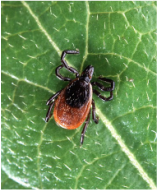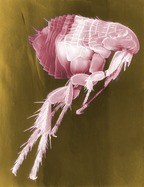A blog for all things dog-related: training, behavior, fun new doggie items, veterinary information and, of course, ways to enhance your relationship with your best four-legged friend!
PREVENTION: There are many kinds of flea and tick preventatives out there – topical solutions, collars, and tablets taken orally. Dr. Selzner advises you should always consult with your veterinarian on what the most appropriate option is for your dog. “That said, there are topical ‘spot-on’ products which are applied monthly, such as Vectra 3D, Advantix, Activyl, and Frontline Plus. At Companion Pet Hospital, we carry Vectra 3D. Some of the topical products have repelling properties, so ticks may not want to bite your dog. There are also several oral flea and tick preventatives available, such as NexGard (given monthly) and Bravecto (given every 12 weeks). Many people like the idea of an oral preventative, because then they and their children will not be coming into contact with the product on the dog’s skin/fur as they normally would when a topical is first applied. One has to use caution with the oral products, because some of them cannot be used until a dog is 6 months or older. Finally, another option is a flea/tick collar- the Seresto collar has become very popular to prevent fleas and ticks. It lasts for eight months and dogs can be bathed with it in place and can go swimming with it on.” Dr. Selzner and I both agree that you should NEVER purchase over-the-counter flea and tick products (such as Hartz, Top Spot, or Sargent’s), as these have been known to create adverse responses in some dogs. It really is best to consult with your veterinarian and get your products through a reputably licensed source.
“Lyme disease is caused by the bacteria Borrelia burgdorferi, which is spread by deer ticks. Transmission of the bacteria requires that the tick be attached to the dog for about 48 to 50 hours. The symptoms of Lyme disease only develop in 5 to 10% of infected dogs.” Really, that’s it?! So this speaks to how important it is to have our dog on a tick preventative – since there’s a possibility he may develop Lyme and we may not even know it! Dr. Selzner says, “Although possible, it is not as common for dogs to develop the bull’s eye rash, which is often seen in people. The symptoms of Lyme disease in dogs can include fever, lethargy, joint swelling, enlarged lymph nodes, and lameness (limping). In more serious cases, Lyme disease can also negatively affect the kidneys, leading to kidney failure. With this scenario, you may see increased thirst and urination, weight loss, vomiting, and decreased appetite.” The good news is that IF your dog is diagnosed with Lyme Disease, there are methods of treatment to help your dog live a full life and diminish symptoms. If your dog is showing any symptoms, most veterinarians will follow up with additional testing such as a full blood panel and urinalysis. Specific antibiotics can be prescribed from your veterinarian, usually in a 30-day course of treatment. “Patients who are showing signs of Lyme disease and also test positive often respond favorably to the antibiotics within 24 to 48 hours.” Another preventative measure may sound obvious, but sometimes we let it fall through the cracks. Keeping your dog vaccinated against Lyme Disease is also significant in cutting down on the likelihood that your dog will encounter this epidemic. “Lyme vaccines are initially given in a series of 2 vaccines, 2 to 3 weeks apart,” says Dr. Selzner. “After the initial series, the Lyme vaccine is given annually. Although they Lyme vaccine is not 100% effective against preventing Lyme disease, it is strongly recommended by veterinarians given the high prevalence of Lyme disease in our area. Even if dogs have tested positive for Lyme disease in the past and have been treated, we recommend continuing to vaccinate them to prevent re-infection.” WHAT ABOUT OTHER TICK-BORNE ILLNESSES? Dr. Selzner give us the low-down… “Aside from Lyme disease, the other most common tick-borne bacterial diseases in our area are Anaplasmosis and Ehrlichiosis. Veterinarians typically perform a blood test called a 4Dx test annually in the hospital to evaluate for heartworm disease, Lyme disease, Anaplasmosis, and Ehrlichiosis. Like dogs with Lyme disease, those who have Anaplasmosis or Ehrlichiosis may have a fever, enlarged lymph nodes, lethargy, stiffness, and a decrease in appetite. Anaplasmosis can also lead to a depletion of platelets (clotting factors) in the body, which can result in bruising on the skin. Ehrlichiosis can lead to a decrease in the body’s white blood cell count. Hence, if your dog is diagnosed with a tick-borne disease, it is beneficial to have your veterinarian also check a routine CBC (to evaluate the red blood cells, platelets, and white blood cells in the body), a Chemistry panel (to assess kidney and liver function), and a urinalysis (to assess kidney function, especially in cases of Lyme disease).” HEARTWORM AND FLEAS: When the weather gets humid and muggy, mosquitos seem to appear from everywhere. Because mosquitos can transmit Heartworm Disease, it’s equally imperative to provide your dog with a heartworm preventative as well. “Heartworm disease is a parasite that is spread by mosquitos and can adversely affect the heart and lungs. Heartworm disease can even be fatal,” Dr. Selzner shares. “After your dog tests negative for heartworm disease at your vet’s office, a monthly heartworm preventative can be prescribed. Heartworm preventatives deworm for several intestinal parasites on a monthly basis as well.” And regarding those pesky fleas? “Both dogs and cats should be on a flea and tick preventative as prescribed by their veterinarian. For dogs, this can be a monthly topical preventative, an oral preventative, or a veterinarian-recommended flea and tick collar. Bathing a patient with a gentle pet shampoo can help temporarily remove fleas and flea dirt (flea feces) from the coat, but we do not recommend using flea dips,” says Dr. Selzner. Why? “Many dogs and cats can have adverse responses to flea dips and use of multiple flea and tick preventatives at once can cause problems. Do not use more than one flea/tick preventative on your pet without consulting with a veterinarian first.”
GETTING RID OF FLEAS: What does this entail? “All bedding (pet and human bedding) should be washed frequently. One should vacuum daily and empty the vacuum bag or canister outside once finished. Additionally, one can even get a flea collar to place in the vacuum bag or canister so that any fleas or flea larvae (baby fleas) that are swept into the vacuum have a greater chance of being eliminated.” Dr. Selzner notes that in more extreme circumstances, “Premise sprays or ‘bombs’ are available help eliminate flea infestations in homes, but be sure to read the directions closely. Many of these require that people and pets be evacuated from the home when the product is used. Others state that you can just spray one room at a time and close it off so that people and pets cannot enter the room for the amount of time specified on the product’s label. In some circumstances, people need to consult not only with a veterinary professional, but with an exterminator as well.” And of course, please be sure the exterminator uses pet-friendly products only! I hope you now know what you’re facing when it comes to fleas, ticks, and some other pests that try to inhabit our lives this time of year. I’d like to thank Dr. Alisha Selzner for taking the time to share her thoughts with us, and if you’d like to learn more about her and how she can help you, call or visit Companion Pet Hospital, located at 8 Route 9 in Fishkill, (845) 896-4830. I’m also in the process of researching some holistic methods for flea and tick prevention, for those of you who may like to live a more holistic lifestyle, so stay tuned! To paws and harmony…
0 Comments
Your comment will be posted after it is approved.
Leave a Reply. |
AuthorMaria Huntoon, CBCC-KA Archives
April 2020
Categories |






 RSS Feed
RSS Feed






